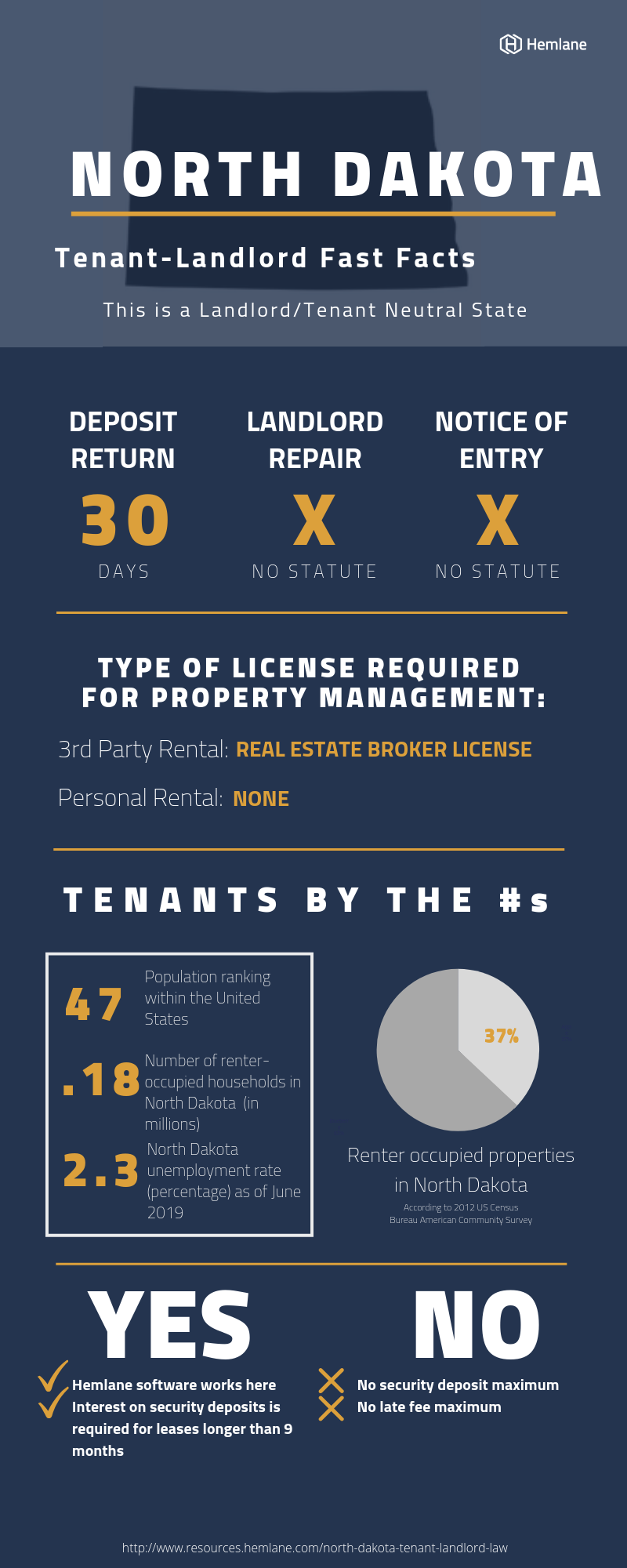North Dakota Tenant-Landlord Rental Laws & Rights for 2025
An Overview of North Dakota Tenant-Landlord Laws
Hey, saw you're renting out your place / signing a lease. Let's skip the boring seminar. After a decade in this game, here's what actually matters in North Dakota. Bookmark this. And yeah, I'll link to the actual laws so you know I'm not making it up.
First, the Security Deposit Dance (And How Not to Step on a Landmine)
Look, this isn't complicated, but somehow everyone gets it wrong. The law is NDCC 47-16-07.1. Read it. The big number is 30.
- If you're the landlord: The millisecond your tenant is out AND they've given you a forwarding address (in writing! an email counts!), your 30-day timer starts. You now have one month to either (a) mail their full check, or (b) mail a letter that lists, in painful detail, every single dollar you're keeping and why. "For damages" isn't good enough. It's "$150 to repaint wall where tenant installed unauthorized shelving, causing 5 anchor holes and spackling."
- If you're the tenant: Your move-in ritual is not unpacking. It's playing detective. Your phone is your best friend. Video tour the whole place. Point out every flaw. "Here's the existing crack in the bathroom tile... here's the stained grout." EMAIL THAT VIDEO TO YOUR LANDLORD. This creates a timestamped record that's worth its weight in gold when you move out. The AG's office says to do this for a reason.
- The "Wear and Tear" Argument: This is where fights happen. A small nail hole from a picture frame? That's life. A fist-sized hole in the drywall? That's damage. Faded paint after 3 years? Wear and tear. Pink paint when the lease said "no painting"? Damage. Use common sense.
The Lease: Actually Read It (Especially Page 2)
I know, I know. But just scan for these two things:
- Is it a 1-year lease or month-to-month? This is huge. A 1-year lease locks in your rent. They can't raise it. A month-to-month lease gives you flexibility, but it means the landlord can send you a letter with 30 days' notice (that's NDCC 47-16-07) saying your rent is going up $200 next month. Or that you need to leave. No reason needed. Choose wisely.
- Is there an "Early Termination" clause? More leases have this now. It might say you can bail for a fee equal to 2 months' rent. In a state where a new job in Fargo or Bismarck can pop up, that clause is an insurance policy. Know the price of your exit.
When Things Break: The "Repair and Deduct" Trap Door
Your heater dies in January. Your first instinct might be to stop paying rent. FIGHT THAT INSTINCT. It's the fastest way to get a 3-day eviction notice slapped on your door.
North Dakota has a specific, legal workaround called "Repair and Deduct" (NDCC 47-16-14). Here's the playbook:
- Tell your landlord in writing (email works) what's broken. Be specific. "The furnace is not igniting. The indoor temperature is 52°F."
- Give them a reasonable time to fix it. No heat in winter? 24-48 hours is reasonable. A dripping faucet? Maybe a week.
- If they ghost you or don't fix it, you can call a licensed pro, pay them, and get a detailed receipt.
- Deduct that exact amount from your next rent payment. Attach the receipt. You've essentially swapped rent money for repair money. You did NOT get free rent. This distinction keeps you out of eviction court.
"Can My Landlord Just Walk In?" No. Mostly.
Your right to privacy is real. They need a good reason and usually need to give you 24 hours' heads up (that's the standard "reasonable notice" in NDCC 47-16-07). Showing the place to a new tenant, making a repair you requested, or a real emergency (burst pipe) are good reasons. "Just checking on things" on a random Tuesday is not. If it becomes a pattern, it's harassment. Start documenting every time it happens.
The Eviction Process: It's a Marathon, Not a Sprint
For landlords: You cannot, under any circumstances, take matters into your own hands. No lock changes. No throwing stuff on the lawn. That's called "self-help eviction" and it's explicitly illegal under NDCC 47-32-06. Doing it makes you the lawbreaker, and you'll be writing a check to your former tenant.
The legal path is slow:
- Notice: Non-payment? A 3-Day Notice to Pay or Quit (NDCC 47-32-01.1). Other violation? A 3-Day Notice to Cure or Quit.
- File in Court: If they ignore the notice, you file paperwork and pay a fee. Then you wait for a court date.
- The Hearing: You both show up with your evidence (lease, notices, your impeccable ledger).
- The Sheriff: If you win, the court gives the tenant time to leave. If they don't, you pay the sheriff to supervise the lockout.
This whole song and dance takes at least 45 days, often 90+. You will lose months of rent. Factor that into your "I want them gone" calculus. Sometimes, offering a "cash for keys" deal (e.g., "$2,000 to be out by Friday with the place clean") is the cheaper, faster business decision.
Why I Finally Gave Up and Got Help (The Hemlane Part)
I'm good with people. I'm good with properties. I am terrible at being a full-time legal clerk, process server, and deadline-tracker. After losing a security deposit case on a technicality (I was 2 days late on the letter), I had enough.
That's when I started using Hemlane. For me, it's not just an app; it's the system that does the stuff I always forgot or messed up. It auto-generates those 3-day notices when rent is late. It screams at me when the 30-day security deposit clock is ticking. It keeps every message, every repair request, every payment in one searchable log, so when I need evidence for court, it's not in my email, my texts, and a stack of papers on my passenger seat—it's just there.
For a tenant, renting from a Hemlane landlord just means stuff gets done. You report a leak in a portal, it gets logged, assigned, and tracked. No more "Did you get my text?" It creates professional accountability on both sides.
If you remember nothing else: Document at move-in. Never withhold full rent. Follow the steps, don't skip them. And when the paperwork feels like too much, it's because it is—get a system or get a pro.
Need the Official Word?
- The full law: North Dakota Century Code, Title 47 (Landlord/Tenant Chapter | Eviction Chapter).
- Plain English Guide: ND Attorney General's Tenant Rights page.
- Help if you're in a bind: Legal Aid of North Dakota.
Last thing: I'm in property management, not law. This is hard-won experience, not legal advice. If you're in a serious bind, talk to a real North Dakota lawyer. It's worth the fee.

Get the Latest in Real Estate & Property Management!
I consent to receiving news, emails, and related marketing communications. I have read and agree with the privacy policy.





